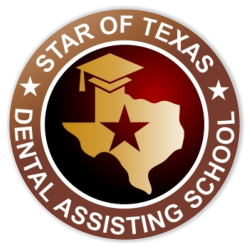About Our Hands-On Job-Training Program
Your VIP Dental Assisting School in Austin
Our dental assisting school in Austin is developed to allow an individual to work and learn the necessary job disciplines to succeed in dental assisting. Our sessions require quick learning of the skills being taught. Therefore, this course is designed to be fully completed in a matter of twelve weeks. There are twelve sessions, which include lectures/videos and hands-on training, during the twelve weeks. Additionally, the student will be assigned clinical training/observation during the work week (Monday-Friday) in which they will chair-side assist and/or observe the Dentist and Assistant as they deliver direct patient care in the dental office. During the twelve week course, the student will do rotations through our Endodontics, Periodontics, and Oral Surgery departments for additional experience in delivering dental care with dentists in a professional environment. There will additional hours of Externship necessary to complete the Program. Program length is twelve days of lecture, lab, and 100 hours chair-side training over a span of twelve weeks.

The course (teaching and externships) will take place in an established dental practice located at 12335 Hymeadow Dr., Suite 250 Austin, TX 78750. The office is approximately 3900 sq. ft. with twelve equipped dental treatment rooms, a laboratory, large sterilization area, business office, and facilities for video and lecture presentations.
Effective September 1, 2006, to apply to become a registered dental assistant, a student must complete a mandatory short course approved by The Texas State Board of Dental Examiners. An approved provider list can be found on the TSBDE website: http://www.tsbde.state.tx.us. By law a dental assistant must be registered with TSBDE in order to take x-rays at a dentist’s office.
Shorter vs Longer Programs
Please click on titles below to expand.
Your employer will have an expectation that you will know the basic skills of assisting. Our Austin dental assistant training program focuses on teaching our students those fundamental skills. We custom design our curriculum around what doctors expect them to know in order to to set our students up for success.
You receive a certificate of completion when you graduate from any dental assisting school. Many students ask if they can expect to make a higher starting salary if they attend a longer school. The answer to that is no. The starting salary for a dental assistant does not have anything to do with how long you spent in school, or how much you paid for your schooling. We set you up to become an RDA, Registered Dental Assistant. The state awards your RDA after you complete our program.
We differ from traditional education in that we are a hands-on training program. Our classes take place in a dental office rather than in a classroom, and a majority of the learning is hands-on. Our classes begin with lecture/class discussion, but a majority of the time is spent in lab, where students are in the operatories learning one-on-one with instructors to take impressions, pour up models, etc. When our students finish the program and begin working, they feel comfortable in the dental office because that’s the environment they were trained in.
“Employment of dental assistants is expected to grow by 31% from 2010 to 2020, much faster than the average for all occupations.” – According to the US Bureau of Labor Statistics
As long as there are dentists, there will continue to be a need for qualified dental assistants. There are many opportunities for entry-level positions, but some dentists prefer to hire experienced assistants. Our dental assisting program includes a 40-hour externship where students will get their first bit of experience.
The mean annual wage for dental assistants was $16.86/hour or $35,080/year reported in May 2012 by the US Bureau of Labor Statistics.
Benefits vary by practice setting and may be contingent upon full-time employment.
What is the Job Description of a Dental Assistant?
Dental assistants perform a variety of duties, including, but not limited to, assisting the dentist, setting up equipment, preparing patients for treatment and keeping records.
Dental assistants may prepare materials for impressions and restorations, take x-rays, make bleach trays, apply topical anesthetics to gums, and place dental dams to isolate teeth for treatment.
Assistants are responsible for making patients feel comfortable in the dental chair and preparing them for treatment.
During dental procedures, assistants work alongside the dentist to provide assistance. They hand instruments and materials to dentists and keep patients’ mouths dry and clear by using suction hoses or other devices. They also instruct patients on postoperative and general oral healthcare.
Dental assistants with laboratory duties make casts of the teeth and mouth from impressions, clean and polish removable appliances and make temporary crowns. Those with included office duties may schedule and confirm appointments, receive patients, keep treatment records and order dental supplies and materials.
Dental assistants work closely with and under the supervision of dentists. Additionally, dental assistants should not be confused with dental hygienists, who are licensed to perform a different set of clinical tasks.

